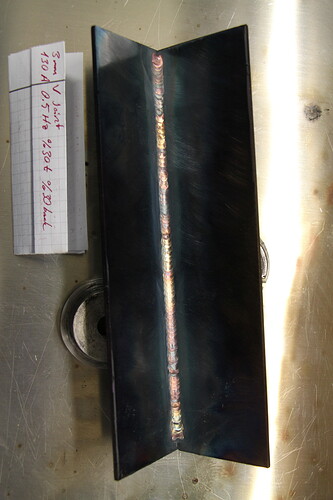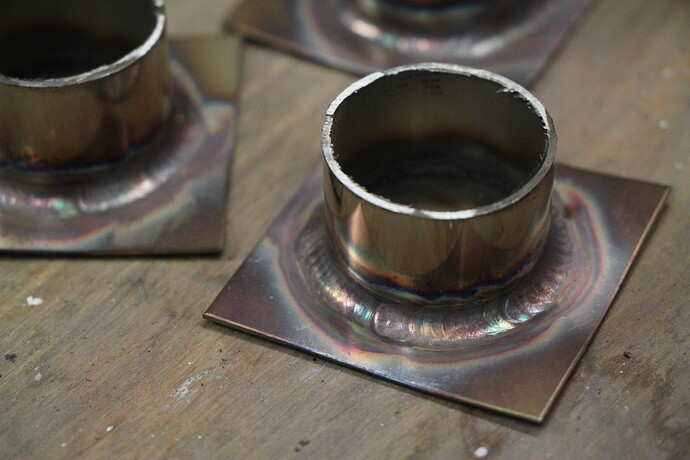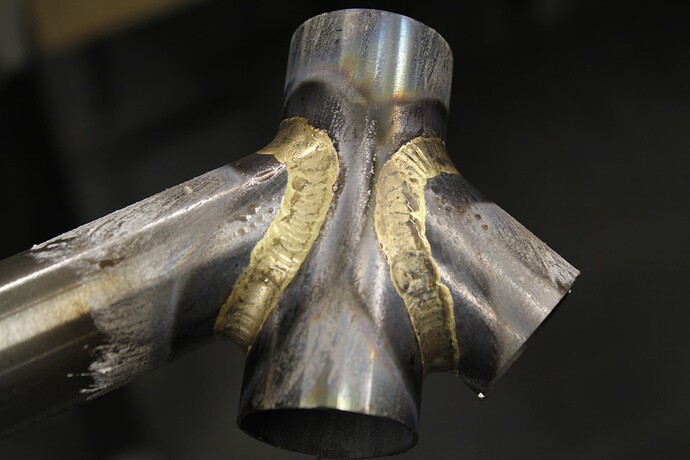The whole thing is turning into a huge mystery. After trying almost everything, I simply used my 0.5mm - 1.0mm tip to braze a fillet. I normally use it for silver. Nothing breaks off with this tip and I can lay a fillet without any problems. Now I have the feeling that my setup is just too hot in general, so I tried to change something on the pressure reducers. Unfortunately, this was also unsuccessful. You just can’t braze with the 1.0mm - 2.0mm tip…
I think the best way to practice brazing (or welding too) before moving to bicycle joints is practising on a straight 90deg V-joint at a horizontal position (using two flat sheet metal plates). Because that eliminates gravity from the equation. You could benefit from that.
This is one of my TIG practices, but brazing goes down the same path.
Then these maybe;
I would suggest going for a smaller flame than you think is needed; and keep the flame really close to the joint at all times. The tip of the cone should be 1-3mms from the puddle. The flame size should be so that; it can melt an existing brass bead in no less than probably 20 secs or so… A small flame is slower but easier to control in the beginning.
This was one of my practices from 5-6 years ago:
I rarely do brass brazing anymore; mostly do silver fillets…
For those who fillet braze with propane, what torch tip size do you use?
0, smallest possible.
What brand is that? A 0 in Victor’s line is the same orifice size as a 2 in Harris, or between an AW203 and AW204 in Smith’s lineup. A Harris 0 is the same size as Victor #000. I don’t know any brand where 0 is the “smallest possible”, most that have a 0 also have a 00 or 000 that are smaller.
Paige propane tips (I use 'em, on a Smith handle) go from M1 to M5. Haven’t done much fillet brazing lately with propane but I think M2 for typical thinwall bike frame stuff, M3 if it’s thicker stuff like BB shell or unicrown. Hopefully someone with more recent experience with Paige tips for fillet will chime in.
I think Victor tips for propane have “TEN-” in the name, like TEN-1 etc. Not a Victor user, myself.
You can use acetylene tips for propane, but it’s annoying how often the flame detaches and gets blown out. Real propane tips are well worth it. I got Paige tips on the recommendation of Doug Fattic and I really like them.
I am using Gloor. And just checked, but I am using a nr1 propane tip, which is 0.5-1.0mm.
Good advice from @Brelis_Cycles.
On the topic of practicing, practice joints etc and fillet brazing specifically I would suggest keeping your stubs long. You can cut em off and reuse the off cut for another. But if you fillet braze really small practice pieces you’ll need a tiny flame and/ or to stop a lot in order to not overheat stuff. That may or may not be useful to inform how you go about brazing a full frame assembly.
For me the quickest way to learn was brazing thicker stuff (double the wall thickness of bicycle tubing for example). And brazing thick old bits of plate to thinner (but still >2.00mm) tube. You can’t really go wrong and it’s fun using a big flame.
Seriously, brazing thin bike tubing is hard. Learn to braze motorcycle frames first and then just dial everything right down for a bicycle - my best advice ![]()
@TDB Yes, I totally agree with that ![]()
I forgot to mention – I am trying to fillet braze using a 2-TEN Victor-style tip. I also bought a 0-TEN tip and found it too small to do much of anything, so (IIRC) I drilled it out to a 1-TEN size.
According to this chart,
- #2 tip size equates to a #56 drill size (diameter .046")
- #1 tip size equates to a #60 drill size (diameter .040")
- #0 tip size equates to a #65 drill size (diameter .035")


